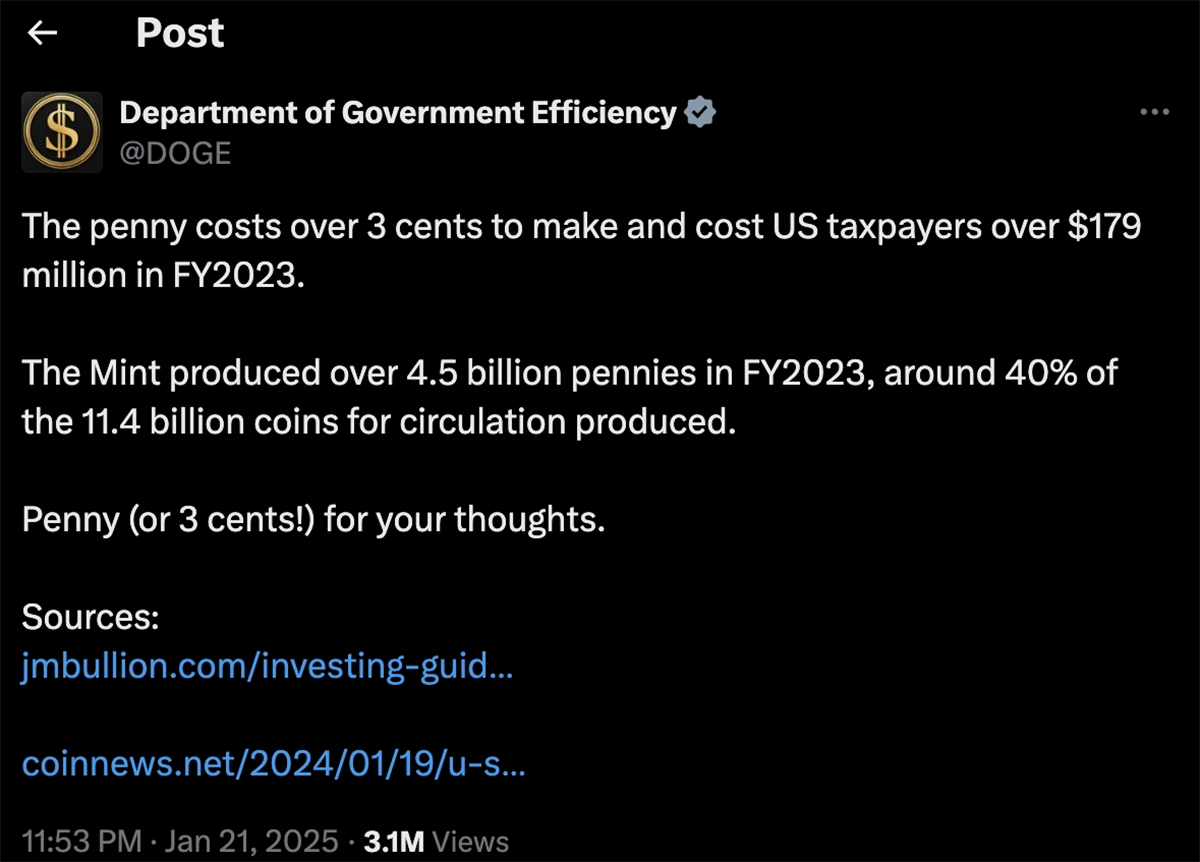Could Penny Be Eliminated During Trump’s Second Term?

By CoinWeek News Staff …..
While Elon Musk’s promised $2 trillion in government spending cuts will probably never materialize, one can’t reduce federal spending by a more realistic amount without counting pennies. According to a January 21 post on X from the Musk-led Department of Government Efficiency–DOGE for short–the venerable penny may find itself in the crosshairs.
It is no secret that the one-cent coin costs the United States Mint more to produce than its face value. The negative seigniorage on the coin amounts to billions of dollars in paper losses for the Treasury, though these are offset by the seigniorage of coins like the dime and quarter. According to DOGE, U.S. taxpayers paid over $179 million in Fiscal Year 2023 for the continued production of the cent, the composition of which was last changed over 40 years ago in 1982 to combat the rising costs of copper.
Advocates for the penny argue that the coin is necessary due to our tax policies and because it is used by millions of Americans – including the roughly 5% of households that are unbanked.

In a 2015 article published on CoinWeek, former Mint Director Philip N. Diehl wrote that the elimination of the penny was “long overdue” and the main reason the penny survives is because most of the coin’s production (outside of stamping the design and bagging it) has been outsourced to private industry.
Eliminating low-denomination coins is not just an issue in America; the elimination of the cent among the leading economic powers has been a touchy subject, as the production of these coins amounts to about 40% of the total output of the world’s leading mints.
Eliminating the Penny Not Far Enough?
But it’s not just whether or not the penny should be eliminated that needs to be considered. Coinage reform in the United States is long overdue.
Of the six circulating coin denominations the Mint produces, only four actually circulate. The Half Dollar has not circulated with regularity since the early 1960s, and the Dollar coin does not circulate because the public prefers the $1 bill. Even as financial transactions happen more frequently via electronic networks, coins still play an important role in the economy, and DOGE and Congress should work together to refresh America’s coins to make them great again.
One suggestion would be to phase out the cent and force consumers and businesses to round transactions to the nearest five cents. Congress should also look at redesigning the half dollar so that it is more practical for use in vending machines and phase out the $1 bill in favor of the dollar coin. Doing this could save the American people real money and preserve American coinage for future generations.
* * *
The post Could Penny Be Eliminated During Trump’s Second Term? appeared first on CoinWeek: Rare Coin, Currency, and Bullion News for Collectors.






















1. This raises a crucial point about the hidden costs of everyday items. We often overlook how much something like producing a penny actually impacts the national budget.
2. The debate around the penny’s future highlights the tension between tradition, practicality, and economic realities. It will be interesting to see how this plays out.
3. I hadn’t considered the impact of private industry’s involvement in penny production. Outsourcing adds another layer of complexity to this discussion.
4. Modernizing currency is a complex undertaking. Balancing public preference with economic efficiency is a tough challenge for policymakers.
5. A holistic approach to coinage reform, addressing multiple denominations, might be more effective than just focusing on the penny. This article offers a good starting point for that conversation.